![[Natalia]/123RF.COM Alternative Milks](/sites/g/files/dgvnsk6006/files/styles/sf_landscape_16x9/public/images/article/altmilks2.jpg?h=170ba4b8&itok=xdpL6vPe)
Udderly Complex: Sustainability of Cow and Plant-Based Milks
“An almond doesn’t lactate, I will confess” was Food and Drug Administration Commissioner Scott Gottlieb’s response during a debate over whether alternative “milks” can really call themselves milks, a conversation spurred by their recent rise in popularity. These “milks,” also known as plant-based milks, are non-dairy beverages made from a water-based extract of crops like soy, oat, rice, and almonds. While liquid milk is “the most consumed, processed and marketed dairy product,” the sales of alternative milks have more than doubled in the last decade. Their rise in popularity is driven further by companies claiming that their alternative milk products are more sustainable, but how do plant-based milks impact the environment, and how does that compare to dairy? The environmental impact of dairy and alternative milks is a multi-faceted issue that has gained traction in health- and environmentally-conscious individuals, so let's dive into this udderly complex topic.
Recently, a team from the University of Oxford created a database that shows the variation in food’s multiple environmental impacts by assessing the carbon footprint and resource usage of many of the foods we eat daily. Their study, published in Science in 2018, included dairy milk and alternative milks. The team amassed data from roughly 38,700 farms globally, making this the largest study ever analyzing the environmental impact of foods. Roughly 10,000 of the farms studied produce crops for alternative milks and another 1,800 raise dairy cows. While each farm operates differently, the team was able to collect data on how these milks impact the environment on a global scale. This environmental impact is broken down based on greenhouse gas emissions, land usage, water usage, and fertilizer runoff. So let’s go through each of these categories and see which of these milks do the worst. But first, which milk is the top offender?
Dairy
It’s dairy: in every single category, dairy has a higher environment impact than all of the alternative milks. The previously mentioned study determined that dairy milk produces more greenhouse gas emissions and uses more water and land than alternative milks. In fact, it takes nine times more land to make a glass of dairy milk than almond, oat, rice, or soy milk. On a global scale, dairy cows graze 830 million hectares of land, an area the size of Brazil. Additionally, three times more greenhouse gases are emitted from dairy cattle in comparison to the farming processes used to make alternative milks. Water usage is a significant issue in the production of dairy milk as well and alternative milk manufacturers have incorporated this into their marketing, with Silk stating that producing one carton of their product uses 80% less water than producing a carton of dairy milk. While it is clear that cow’s milk has the highest overall environmental impact, each of the alternative milks are not faultless when it comes to greenhouse gas emissions, land usage, water usage, and fertilizer runoff.
Greenhouse Gas Emissions
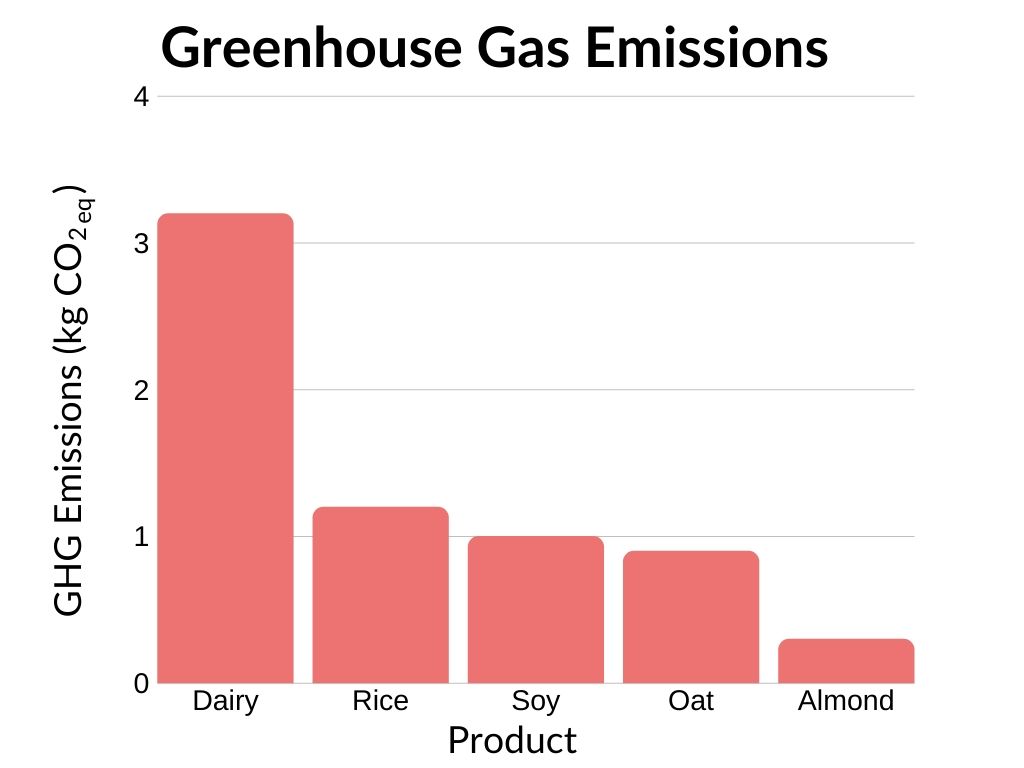
The winner for most greenhouse gas emissions is also the winner for most waterlogged: rice. Rice production emits the most greenhouse gases amongst the alternative milks because rice fields are flooded as part of their farming procedure, and bacteria in the flood water create methane. Essentially, the flooding of rice paddies leads to oxygen depletion in the soil which means only organisms that do not need oxygen to survive can proliferate in this soil. When an organism does not need oxygen to survive, its metabolism often produces methane after consuming organic matter in the soil for food. Therefore, the bacteria and microorganisms that live in the oxygen-depleted rice paddies emit copious amounts of methane. However, it is important to note that the 1.2 kg carbon dioxide equivalent of greenhouse gases that rice milk emits pales in comparison to dairy’s 3.2 kg carbon dioxide equivalent, and the rest of the alternative milks trail closely behind rice milk with almond at the lowest with 0.7 kg carbon dioxide equivalent emitted.
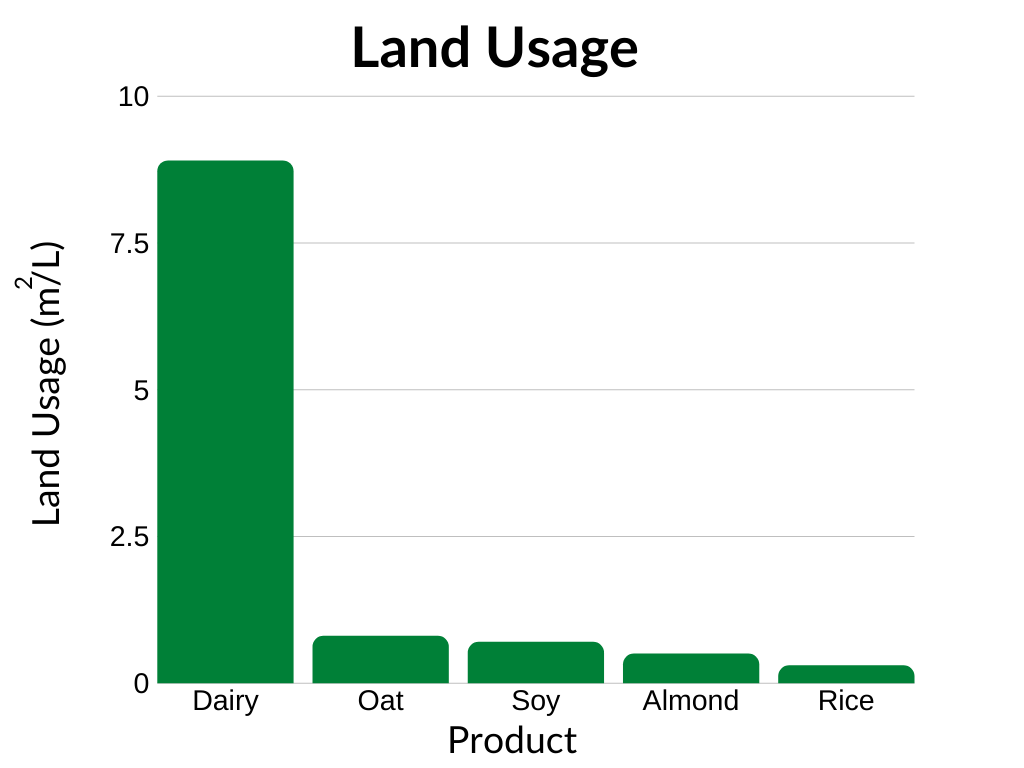
Land Usage
Although dairy cows occupy the most land of all the milks, making a glass of soy and oat milk uses more land than almond or rice, largely due to widespread use of these crops in countless food products. Unfortunately, soy farming could lead to the deforestation of the rainforest because some soy farms are located in the Amazon. These particular farms are found in Brazil, an important producer of soy with a soy beverage market estimated to reach a value of 420 million US dollars by 2023. In fact, Brazil is currently the world’s largest producer of soy, but this economic activity comes at the cost of using deforested land. In Brazil, soy farms that are greater than 2000 hectares in size may only constitute 1% of all agricultural establishments in the nine Amazonian states, but they make up 46.8% of all land converted from forest or cerrado (Brazilian savannah) to agriculture. Therefore, soy production has been rapidly expanding into the savannah and Brazilian Amazonia since the late 1990s.
Water Usage
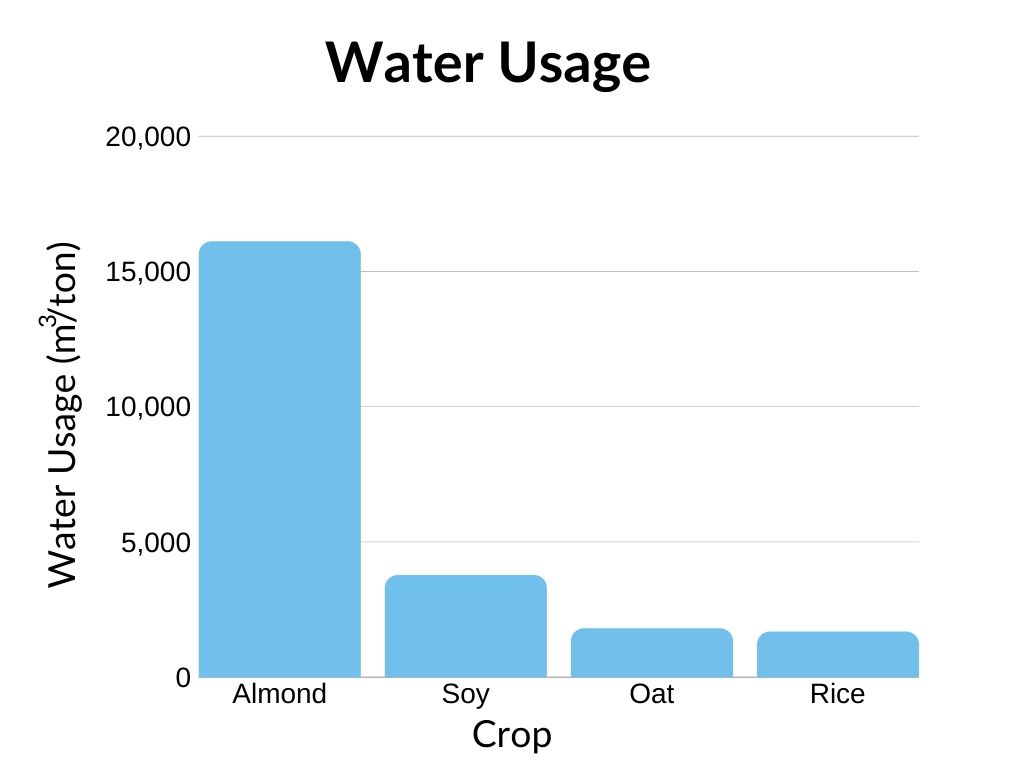
When it boils down to it, almonds use the most water in comparison with the rest of the alternative milks. Most of this water is being guzzled here in the United States as the US is the world’s largest producer of almonds with some 80% of the global market. The US has 350,000 hectares of almond farms and is capable of producing more than 800,000 tons of crop. Almost all of America’s almonds are grown in California, a state with little rainfall, and while almond trees can survive on as little as 7.6 inches of water, they produce maximally with 54 to 58 inches. For reference, the winter of 2019-2020 saw only 1.8 to 7.4 inches of rainfall in regions of California with almond farms. Years ago, many California almonds were grown only with rainfall stored in the soil, but they produced low yield and were alternate bearing, a phenomenon in which an almond tree produces flowers one year and almonds the next which greatly hampers yield. As production pressure increased, almond orchards began to receive applied irrigation water to improve yield and quality, thus solidifying almonds’ dependence on irrigation in California. Irrigation in California is a unique and extensive system for storing and delivering water from water-rich regions to arid regions. Thereby, almonds depend on an extremely energy intensive water system for irrigation. Another global study also found that almonds take at least 4 times more water to grow than rice, oats, or soy.
Fertilizer Runoff

Earlier, we indicated that rice is the alternative milk emitting the most greenhouse gasses. Growing rice also has another problem: fertilizer runoff. Because rice is grown in a few inches of water and then drained to promote growth and prevent weeds, fertilizer can runoff with the drainage water. The drained water contains high levels of dissolved nitrogen and phosphorus that end up in rivers, streams, and eventually lakes and oceans. This can lead to eutrophication, a phenomenon in which excess nutrients cause a dense growth of plant life and the death of animal life from lack of oxygen. Fertilizer runoff from rice paddies has been severely damaging the Taihu region of China, where nitrogen and phosphorus inputs have significantly increased in the past two decades and Taihu Lake, the third largest freshwater lake in China, has seen an acceleration in eutrophication. In this region, fertilizer pollution from the rice production system is considered to be one of the largest contributors to environmental deterioration. In comparison to the other alternative milks, rice milk production creates three times more fertilizer runoff.
The case for dairy
On a global scale, it is clear that dairy’s environmental impact greatly surpasses that of the alternative milks. But what about local dairy practices? A study comparing modern (2007) US dairy production to historical practices from 1944 found that modern dairy practices use 21% of animals, 23% feedstuffs, 35% of the water and 10% of the land required to produce the same one billion kilograms of milk. As for environmental impact, modern dairy practices have 37% of the carbon footprint, produce 24% of the manure, 43% of the methane, and 56% of the nitrous oxide per billion kilogram of milk compared with milk produced in 1944. Milk yield has also undergone a four-fold increase from 1944 to 2007, largely due to advances in genetics, nutrition, and herd management. This means that less cows are needed to produce the same amount of milk, thus leading to a smaller environmental impact. Specifically, today’s dairy industry is capable of producing 59% more milk with 64% fewer cows, leading to a 77% reduction in feed and 65% less water needed to produce a liter of milk compared with the dairy production of 1944. Overall, US dairy production has seen a measurable and extensive shift towards more sustainable, efficient practices over the past 60 years which can only mean dairy is going to become more and more sustainable in the US.
Nutrition
Cow’s milk has long been touted for its nutritional quality as it is a great source of protein, calcium, and vitamin D. Since the 1980s, milk has been viewed as a lynchpin in not only American eating habits, but also American culture with the rise of the “got milk?” ad campaign in 1992. The campaign boasted milk as being the key to strong bones and strong muscles for adults and children alike. And cow’s milk is well deserving of this acclaim; one 8 ounce (240mL) glass of 2% milk comes with roughly 8 grams of protein, 293 mg of calcium, and 120 IU of vitamin D for only a mere 122 calories. So what happens when you switch away from nutrient-dense dairy milk? Are you getting the same amounts of nutrients?
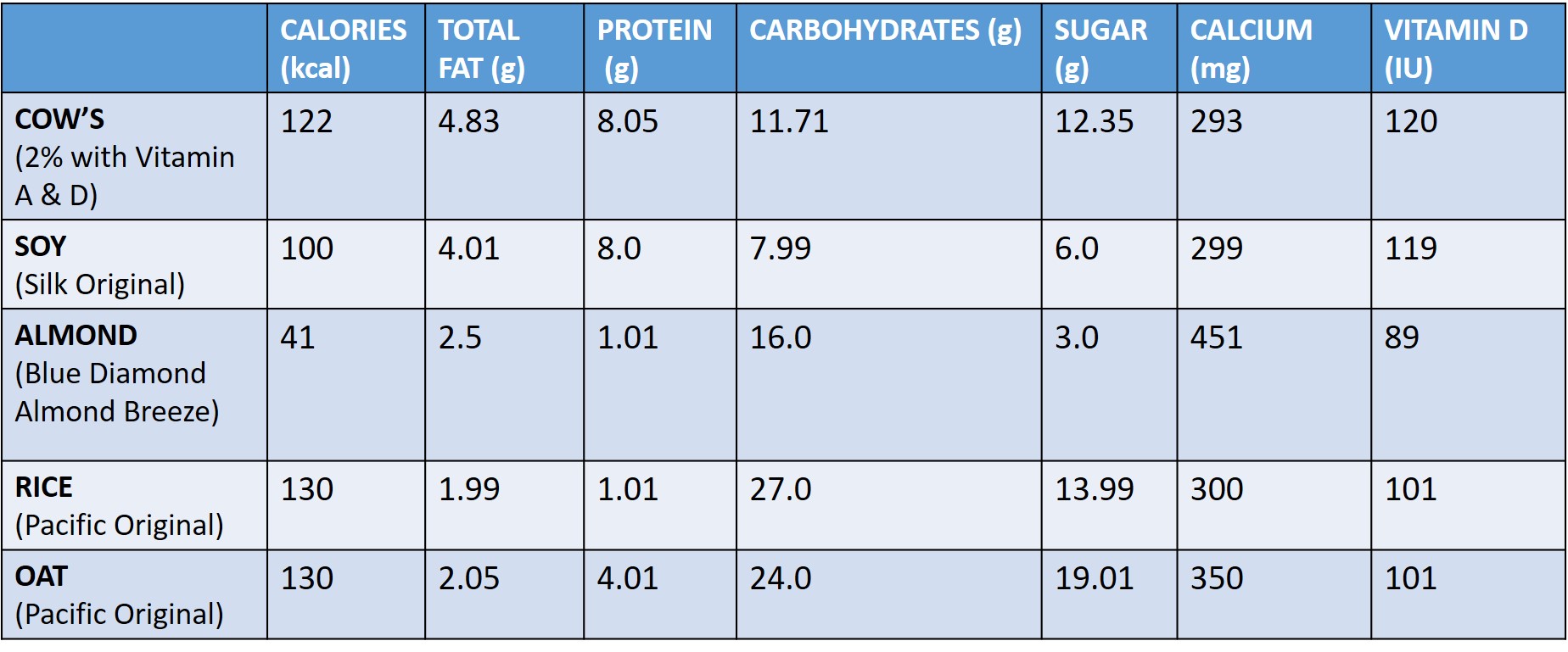
Yes and no, in short. It depends on the type of alternative milk and the nutrient; for example, a cup of soy milk has roughly the same amount of protein as cow’s milk, but a cup of almond or rice milk only has an eighth of dairy’s protein. Almond milk is the lowest in calories across cow’s milk, soy, rice, and oat milk with only 41 calories per cup, but also has the least vitamin D with only 75% of dairy’s vitamin D. Most alternative milks also have added sugar, and oat milk comes out on top with 19 grams of sugar per cup in comparison to dairy’s 12 grams of naturally occuring lactose. Calcium and vitamin D are comparable across all five milks, largely due to efforts to fortify alternative milks. So a switch from dairy to almond milk, one of the most popular alternative milk choices on the market, would necessitate eight glasses for the same amount of protein as cow’s milk. From an environmental standpoint, that would mean dairy cattle and almond farms use equal amounts of land per gram of protein and emit nearly the same amounts of greenhouse gases. However, a switch from cow’s milk to soy milk would reap both the nutritional benefits of dairy and the lower environmental impact of soy. Clearly, the environmental impact of these milks can change greatly when nutrient content of alternative milks versus dairy milk is taken into account.
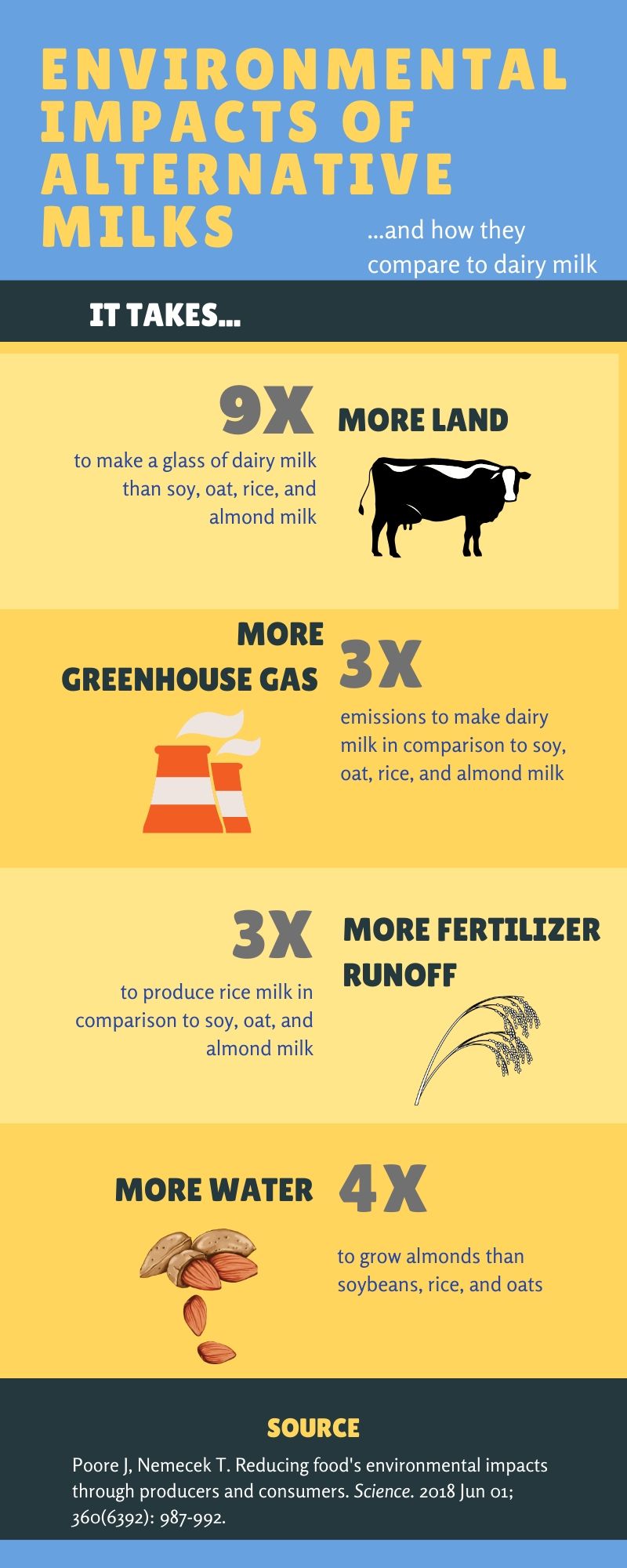 Wrapping up
Wrapping up
In a podcast interview, one of the co-authors of the food environmental impact study previously mentioned was asked the question we’re all probably wondering at this point:
“So which alternative milk is the best?”
His answer is telling (and slightly unsatisfying):
“They’re all so low impact compared to dairy milk, if we chose to change to any of them it would be beneficial. I can’t give it to you, I can’t give you a clear winner.”
Dairy clearly has the largest global environmental impact of all the milks, so what would happen if people switched to an alternative like soy milk? Well according to the co-author, if everyone in the world switched from dairy milk to soy, it would save half a billion hectares of land (an area the size of the European Union and India combined), almost a billion tons of greenhouse gases, and an amount of water equivalent to everyone in the world not showering or bathing for a year. These stats are staggering, but it is worth mentioning that several dairy cattle farms in the United States are actively changing their production strategies to be less environmentally impactful. This means that US dairy milk is more environmentally sustainable than these global statistics are capable of delineating. On another note, it is important to highlight that not all alternative milks are created nutritionally equal to cow’s milk and adjusting the consumption of non-dairy milk to match dairy’s nutrition can also significantly increase their environmental impact. The sustainability of dairy and alternative milks is a multi-faceted, complex, and ever-changing question, but certainly one that is worthy of discussion and milking for all it's worth.
Mishi Vachev is a graduate student in the Plant Biology program at UC Davis. She works on finding genes that lead to resistance to fungal diseases in strawberry in Dr. Steve Knapp’s lab. She also is studying genes that control how strawberries respond to daylight length and how that affects fruit production. She is currently a science communication intern with the Institute for Food & Agricultural Literacy (IFAL) and the Innovation Institute for Food and Health. You can follow her on twitter @MishiVachev.
For more content from the UC Davis science communication group "Science Says", follow us on Twitter @SciSays.

Comments